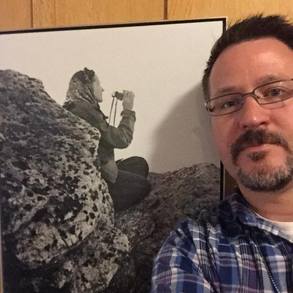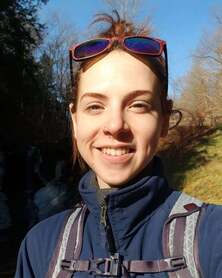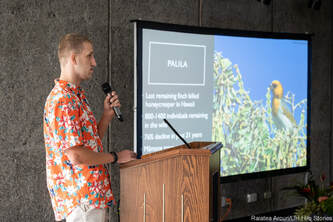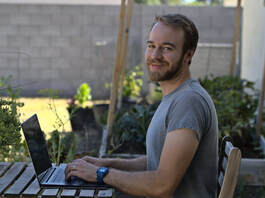Meet The Muth Lab
@ JuniatA College
|
Norris Z. Muth | Principal Investigator
Professor of Biology, Juniata College Ph.D. Ecology & Evolution, Stony Brook University, 2007 M.S. Forest Science, Yale Forestry and Environmental Studies, 1999 B.A. Environmental Studies, Brown University, 1997 My own undergraduate research began in 1995 studying several aspects of the purple loosestrife invasion in Rhode Island. I've been involved in undergraduate research and invasive species in one form or another ever since. NZ Muth CV - edited June, 2018 |
Current Students
|
Allison Koehle | Biology
Alli has been involved in numerous lab projects and is lead author on the submitted manuscript Headwater stream community resistance to Hemlock Wooly Adelgid (Adelges tsugae) induced eastern hemlock (Tsuga canadensis) decline. Alli received an award for her presentation of this work at the Natural Areas Conference (2019, Pittsburgh) and also presented her work at the North American Congress for Conservation Biology (2019, Toronto). Alli defended her honors thesis in December 2019 and currently has a bioinformatics internship at the NASA Jet Propulsion Lab. |
|
Hannah Hauck | Environmental Science Education
Hannah is working with the Ferguson Township Parks and Recreation Committee to develop methods that encourage the community to become more involved in the biological exploration of Township Parks. Some examples using iNaturalist can be seen by clicking here. |
|
Allasandra Valdez | Biology
Ally has been involved in a number of lab projects, including taking a lead role on the "Caterpillars Project." In this study Ally is assessing the differential food web effects of planting native versus non-indigenous trees in residential areas. In addition to the fundamental research approach, Ally and the lab are hoping to raise awareness of simple ways people can impact their local environments and promote healthier ecological communities. |
|
Sydney Riegel | Biology
Sydney recently joined the illustrious ranks of the "Caterpillars Project" people. The project is focused on assessing the differential food web effects of planting native versus non-indigenous trees in residential areas. In addition to the fundamental research approach, the project also seeks to raise awareness of simple ways people can impact their local environments and promote healthier ecological communities. |
Lab Alumni
|
Naomi Miller | Graduate Student, Stonybrook University (Go Seawolves!)
Naomi spent most of their time in the lab working on the effects of habitat and host nativity on aboveground arthropod communities (devising the protocols, collecting the data, supervising the sample identifications, and all aspects of analysis and write up) and will be a coauthor on the forthcoming publication. |
|
Alex Bischer | Graduate Student, University of Hawaii
Bisch worked with Emma Johnson to document the plant communities of Sparks Farm. |
|
Emma Johnson | COPE Center, Inc
Emma worked with Alex Bischer to document the plant communities of Sparks Farm. |
|
Meaghen Stewart | Pittsburgh Zoo, assistant manager of visitor services
Meaghen participated in a number of lab projects while at Juniata. She helped collect pilot data for the caterpillars project, and with collaborators Marissa Cubbage and Catherine Neville, coauthored the study Local ecosystem uptake of stocked trout by Cambarus bartonii and the relevance of prior exposure to stocking. |
|
Marissa Cubbage | Purdue University, MS candidate
While at Juniata, Marissa completed independent research on crayfish feeding ecology and seasonal activity in mountain headwater streams (ultimately coauthoring Local ecosystem uptake of stocked trout by Cambarus bartonii and the relevance of prior exposure to stocking). Interested in aquatic systems above and below ground, Marissa worked for two years at Lincoln Caverns as a cave interpreter and outreach staff member before entering a MS program at Purdue University. At Purdue, Marissa’s MS research focuses on variation in habitat quality for larval fish in Lakes Huron and Michigan. |
|
David Toole, MS | Genomic Data Management
While working in the lab, David was lead author on the study: Differences in soil fungal assemblages associated with native and nonnative tree species of varying weediness. |
|
Gabrielle Cannon | Research Specialist, UNC Chapel Hill
While working in the lab, Gabby worked on numerous projects and earned coauthorship on two studies. Differences in soil fungal assemblages associated with native and nonnative tree species of varying weediness. and Assessment of plant community restoration following Tree-of-Heaven (Ailanthus altissima) control by Verticillium albo-atrum. |
|
Jennifer Graves, MS | Coordinator, Desert Fish Habitat Partnership
While working in the lab, Jen worked on a number of projects including protocol development and data collection for her coauthored study: Differences in soil fungal assemblages associated with native and nonnative tree species of varying weediness. |
|
Catherine Neville | Visitor Educator at New England Aquarium
While working in the lab, Cat, and colleagues Marissa Cubbage and Meaghan Stewart, published their study Local ecosystem uptake of stocked trout by Cambarus bartonii and the relevance of prior exposure to stocking. |
|
Max H. Ferlauto | Graduate Student, University of Maryland
Max spent most of her time in the lab working on the effects of habitat and host nativity on aboveground arthropod communities (devising the protocols, collecting the data, supervising the sample identifications, and all aspects of analysis and write up) and will be a coauthor on the forthcoming publication. Max received a NSF GRFP to conduct his graduate work at UM. |
|
Annaleigh Baremore | Global Sustainable Development & French
My primary study is a group project focused on the differences in arthropod communities inhabiting native and non-native tree species (across urban and natural areas). We presented our initial findings at the 2016 PA Botany Symposium. ● I have also worked on the Huntingdon Street Trees project. ● My interests are primarily in Botany (trees in particular) as well as Sustainability and Conservation. I previously worked with the Student Conservation Association and I’m interested in working abroad on projects devoted to combating deforestation and promoting sustainability. In my free time I enjoy hiking, music and learning languages. |
|
Kendra Bierman | Environmental Science
I am working with a group of students, studying the impact of tree nativity and location (urban or natural area) on the resident arthropod population. Greater diversity and abundance of arthropods on native vegetation points to the importance of native species to ecosystem function. Our initial findings were presented at the PA Botany Symposium, PA Wildlife Society Conference, and Juniata’s Liberal Arts Symposium. I have also been involved in the Huntingdon Street Tree project. |
|
Patrick Harris, MS | Operations Manager, Helltown Brewing
Pat Harris took the lead on the Tree-of-Heaven restoration study and is lead author on Assessment of plant community restoration following Tree-of-Heaven (Ailanthus altissima) control by Verticillium albo-atrum. |
|
Nathan Smith, MS | Arizona State University, PhD candidate
While working in the lab, Nate worked on numerous projects and is a coauthor on Assessment of plant community restoration following Tree-of-Heaven (Ailanthus altissima) control by Verticillium albo-atrum for which he developed and executed initial sampling protocols. Nate is studying food choice in leaf-cutter ants for his doctoral dissertation. |
|
Acer VanWallendael, PhD | MSU, postdoc
Acer was an inaugural member of the lab. in the lab Acer's work focused primarily on the impacts of black walnuts on co-occurring vegetation and is coauthor on the related publication, Cracking the walnut case: revisiting claims of black walnut toxicity. Acer currently works in the Lowry lab studying the genetic basis of biofuel switchgrass susceptibility to fungal pathogens. |
































